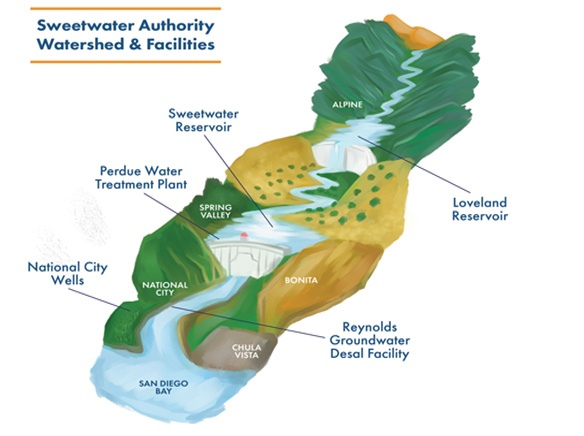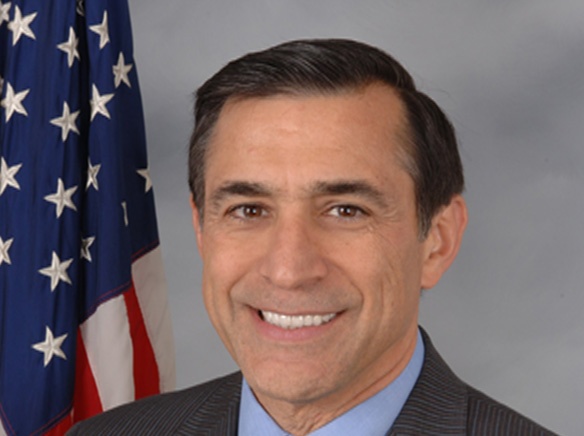
In November 2022 the Sweetwater Authority initiated a controlled transfer of water between the Loveland Reservoir to the Sweetwater Reservoir where water is treated and distributed to Authority customers in National City, Chula Vista and Bonita. The Loveland Reservoir, owned and operated by the water utility, was built in 1945 pooling water from the Sweetwater River. It has been an East County destination for fishing, birdwatching, and hiking. After a second water transfer in January between the two reservoirs and substantial storms which caused damage to the Hud-funded fishing pier and erosion damage to the trails, Loveland is now closed to the public for all recreational usage for an indefinite period of time.
Authority General Manager Carlos Quintero said, bottom line, with both water transfers there is not enough water to fish. He said Loveland has always been a water supply reservoir,
“Our mission is to provide water to the Sweetwater customers,” he said. “We use both of our reservoirs. They work in conjunction. Sweetwater is in Spring Valley and that is where we have our treatment plant. When conditions are optimal, when we are outside the arroyo toad breeding season, that is when we can transfer water from one reservoir to another. It is a 17-mile trek for every drop of water, and we try to find the optimal conditions to minimize our losses.”
Quintero said one thing they are seeing in this “new climate” is that the soil is extremely dry, so we lose water to the soil, calling the soil a dry sponge that has to fill up before we retain water. He said the first water transfer in November 2022, if they had known about the storms that came in December and January, things would have been a little bit different.
“The reality is that we were down to about 400 acre feet of treatable water at the Sweetwater Reservoir,” he said. “We use approximately 25 acre feet of water every day, so generally speaking, 50% of our water comes from surface water or imported water, and the other half comes from our groundwater desalter and wells we have in National City. So that is not a lot of water, so we had to transfer as much water as we could to continue to treat water from the reservoir at Sweetwater Authority.”
Quintero said it had some losses, but gained those losses when the rains came.
“With the storms there was a lot of erosion (at Loveland) so we decided to close the access all together,” he said. “We did not want anybody to get hurt. We will be doing an assessment and possibly some short-term repairs to make sure that it is safe. Longer term issues like the fishing float, those will have to come later.”
The fishing float was installed in December 2009, when the water level was higher. Quintero said right now, getting down to the fishing float is extremely challenging with no real access and getting heavy equipment down to move things around is too challenging and probably very expensive. He said the float was damaged in the January storm over the Martin Luther King Jr. holiday weekend, with too much water coming in too fast until the float collapsed.
Quintero said the Authority is working with its insurance company to make sure they can cover some of the damage, but like much of the state after the recent storms, there has been no disaster declaration in San Diego County for FEMA, to his knowledge, so at this point he does not know if there is any FEMA funding available. He said they filed a damage report assessment with the County.
Quintero said the reality of the situation is that the Sweetwater Authority owns the water rights to the Loveland Reservoir.
“Our main mission is to provide water at the lowest price possible,” he said. “Our surface water is our cheapest water. Any water authority will provide water at probably twelve times the cost of surface water, from the untreated aqueduct. Treated water costs about 15 times more. So, we always try to maximize the use of local water.”
To protect and preserve water quality and the natural habitat, Sweetwater Authority and the USDA Forest Service established a partnership in 1997 to provide public fishing access along a five-mile portion of the shoreline. In exchange for a parcel of land near the reservoir, previously owned by the federal government, Sweetwater Authority provided land near Descanso, California to the National Forest System. This exchange increased natural habitat and forest lands available to San Diego County and Southern California residents and wildlife.
“There was nothing in that easement, or anything else that transferred or sacrificed, or gave away water rights,” he said. “It is exclusively an access easement. Activities such as hiking, birdwatching, fishing are allowed if the resources are there. The way we see it, the [board of directors] has been very supportive of recreational activities, but these activities are incidental to having sufficient water. Historically it has been the case that there has been more water at Loveland, so it has not been an issue. We have not had Loveland near its capacity since around 2009.”
Quintero said reservoirs across the state that are solely fed by runoff are not in the best shape. Researchers are saying that California is going longer times without water, then getting a large amount of water in a very short period of time. “It is challenging,” he said.
“I understand those who were used to fishing at will, but times are a bit different. Having said that, if we get a miracle March or April that put the reservoirs more at historical levels, fishing would be available. There has been no commitment, no transfer, no gift of water rights to recreational activities.”
Now Quintero said after nearly four years of drought, the Sweetwater Reservoir is very close to 50%, but it has not been at 50% since June 2019. The total storage of Sweetwater is about 28,000 acre feet, and being close to the 14,000 acre foot mark, that gives them almost 14 months of providing the cheapest water to its customers.
“It is certainly much better than November when we were down to 4,000 acre feet with about 400 acre feet of treatable water,” he said. “Once the level gets too low it is extremely challenging to treat. It sounds like we got a lot of rain, but it takes a lot. You need these series of storms to start saturating the soil. I am not only talking about the riverbed, but I am talking about the whole watershed.”
Quintero said the Palo Verde Lake north, and the lake at Willow Glen Golf Course must fill up first before collecting at Loveland.
“By the time we had the fourth or fifth atmospheric river, that is really when we got a whole bunch of water in one day,” he said. “We probably had about, combined Loveland and Sweetwater reservoirs, about 20% of all of our annual water supply in one day.”














Why no comments from the public? No investigation of the dark sides , many of them? This looks like PR work for Sweetwater. I left a note at the office during the taste of Alpine and called later in the week and nobody responded. Over the past couple of years I tried to get coverage of the threat to drain the lake several times.
The Recreational access easement is a legal document that guarantees access to hiking and birdwatching above the High water line from Sunrise to Sunset 365 days a year. There is no damage or hazard to the Eastern portion of the Housing and Urban Development funded trails. The ADA access and ramp and trails to the fishing float, that could also provide equipment access, were never installed. The main parking lot and the smaller lot to the East are also the only safe parking for access to the Cleveland National Forest lands to the North used by Hikers, Mountain Bikers, and Equestrian Riders. Many Road cycling enthusiasts utilized the facilities as well. The water that went into the ground during the transfer was not lost. It percolates into the water table which the Sweetwater Authority has access to. It would require a very large document to talk about habitat disruption to even a few of the wildlife species affected by these transfers both at the reservoir and downstream so I won’t start that discussion. There is a long well documented history of concern by environmental groups and land management experts regarding these issues. The Loveland Reservoir is a regional environmental and recreational asset that needs to be open and maintained for all users. I fully agree that the lowest portion of the access trail needs to be closed off temporarily for safety and the rest of this local treasure reopened immediately. Perhaps just a little bit of the 11 million dollar savings claimed could be used to achieve the implementation of the full HUD plan allowing for Social and Environmental Justice to be restored along with the Sweetwater Authority’s relationship and reputation in their community as well.
This article is biased and in defense of Sweetwater Water Authority – SWA. Why don’t you do an article on the complete devastation committed to Loveland Reservoir = the dead fish all over the bottom of the reservoir, the displacement of every single living dependent animal and bird around the reservoir. NO WATER after 100 years of animals in the area dependent on the water now have none. The firefighters have zero resources via water for fighting fires. Sweetwater stole from us to give to them – only those in South Bay. This is criminal. On top of that they did it without an Environmental Impact Report. The impact on the environment is so severe, it can’t be outlined yet they did it without an EIR. Criminal !
Telling half truths isn’t journalism with integrity. I hope the community will receive a subsequent article that includes facts to counter the SWA spin.
Sweetwater Authority’s indifference and lack of accountability toward environmental stewardship is incredible. California has a history of water mismanagement, and SWA continues this trend into 2023. While Padre Dam is planting oak trees around their reservoirs to protect the environment surrounding their reservoirs, SWA thinks just because they “own the water rights”, they are not accountable if their actions cause massive erosion and destruction of the local habitat. Bird watching has been virtually non-existent around the reservoirs due to previous water let downs…the coastal sage scrub has been replaced with mustard and horseweed, invasive plants not conducive to a healthy habitat required by our native birds, but are VERY conducive to FIRES. Only water birds were consistent, that is, until the Nov 2022 drain to DEAD POOL. Breeding seasons (as mentioned above for the arroyo toad) are not magical moments that occur during a particular time of year. Breeding seasons occur when the habitat is healthy year round. Habitats cannot quickly recover simply because a major destruction event was implemented outside of breeding season. What helped maintain the environment was MINIMUM POOL status. Fishing access may be incidental to water rights, but ENVIRONMENTAL STEWARDSHIP is NEVER incidental. This issue is beyond recreational activities. Water management can not be about predicting future rainfall, but must be about preserving and/or improving current conditions. Environmental stewardship is what protects water rights for years to come, and THAT is what saves water customers money. SHAME ON SWEETWATER AUTHORITY.
Where are all the comments? Saw at least four earlier; now none? Nice that the SWA is inviting us to fish at Sweetwater Reservoir since they took the water from Loveland and killed all our fish.
Sweetwater Authority should be held liable for killing thousands of fish and un-number of turtles. No attempt was made to relocate fish to another reservoir. No fire fighting water for any fires in East county. No place for migratory birds.